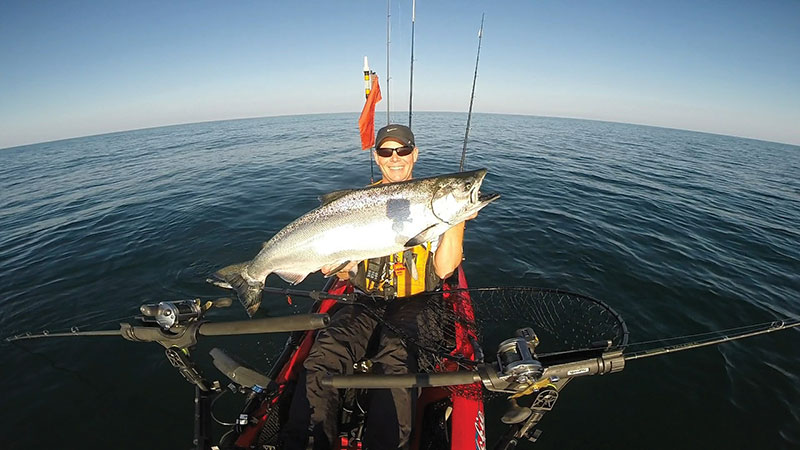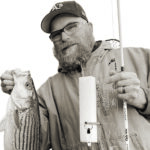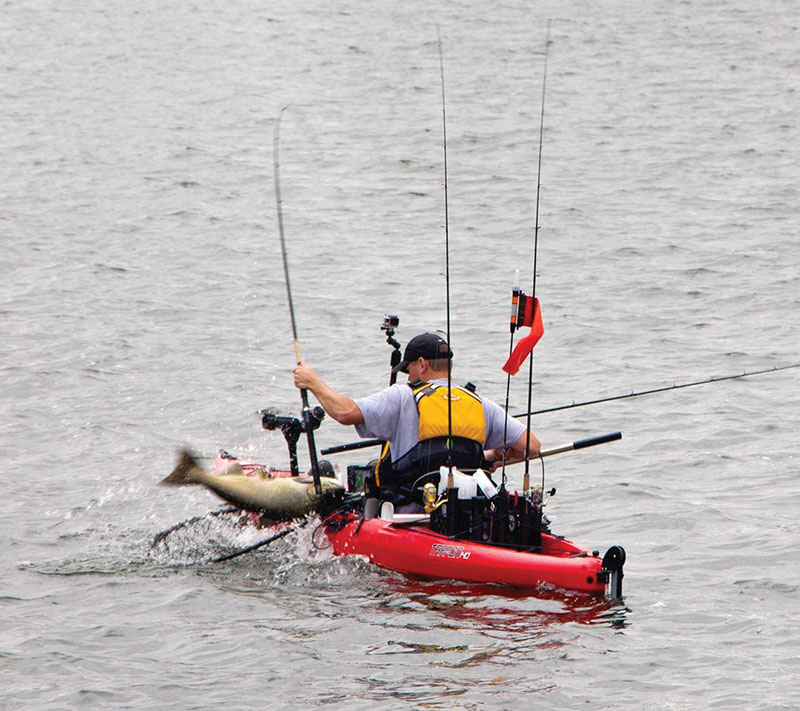
Fishing out of a kayak is easy and fun!
by Dave Mull
Trolling for Great Lakes salmon and trout out of a kayak? Ask anyone who has battled a Chinook, brown trout, steelhead or laker from a little plastic boat: It’s crazy fun.
A kayak makes a great, affordable second boat. Easy to store and transport with paltry maintenance costs, the only fuel needed is what you had for breakfast.
You can even add a trolling motor and, with enough battery power, troll all day.
In July 2022, Nick Van Gompel of Cedarburg, Wisconsin, trolled his way to a $25,000 prize in the 48th Annual Salmon-A-Rama, based in nearby Racine. Van Gompel pedaled his 14-foot Hobie Pro Angler into the pre-dawn darkness of Lake Michigan and hooked into a giant 34.95-pound Chinook that broke his landing net when he hauled it into his kayak. His fish reigned as the biggest of the derby — outpacing anglers in big trolling cruisers.
Van Gompel, now in his 10th year of kayak fishing, offered some advice on how to find, hook and land fish from a kayak while emphasizing safety.
Outfitting
First, a kayak with human-powered pedals to swing flippers back and forth or turn a propeller works way better for trolling and fighting fish than a paddle-powered kayak does. Pedal power leaves hands free for setting rods while moving forward, minimizing tangles. When reeling in a fish, pedals keep the small boat moving forward with the fish behind and above your other lines.
Van Gompel often fishes for a couple of pre- dawn hours before work as Chinook (aka king) salmon are notorious night feeders. The 40-year- old pharmacist’s Hobie has the mandatory white stern light and he installed a string of LED lights along the gunnels to make himself more visible. He also wears a head lamp to help set lines in the dark and land fish.
He trolls with the Wisconsin legal maximum of three rods. Two 9-foot rods set in RAM brand rod holders are forward and stick straight out, parallel to the lake surface on both gunnels. A third 71/2-foot rod runs a lure down the “chute” behind him. He runs lures behind Torpedo Divers on all three rods. Torpedos are super-efficient weights that he hangs on the fishing line with Offshore clips. He uses 12-ounce Torpedoes on the sides and an 8-ouncer down the middle. Okuma line-counter reels filled with 30-pound test braid act like downriggers.
Like most modern fishing kayaks, Van Gompel’s Hobie easily accommodates an electronic sonar/GPS unit, which shows fish depth, water temperature, location and kayak speed. He sets lures down so they run just above the fish and he keeps the speed at 2 to 2.2 mph. Any slower and lures lose action; any faster and pedaling anglers can wear themselves out.
Lures are spoons and flasher-fly combos. He said he usually runs one flasher-fly (a whirling plastic paddle with a tinsel fly behind it) to attract fish. If the fish prefer spoons, he puts out three of those as they’re easier to run tangle-free than a flasher-fly.
To keep tasty salmon for the table, various companies offer insulated fish bags to carry ice and the catch. Van Gompel has insulated the large front hatch of his Hobie and can ice down a limit of five fish inside. Sometimes really big fish, such as his Salmon-A-Rama winner, leave their tails sticking out of the compartment. But, he notes, that’s a good problem to have.
Safety first
Common sense and safety go hand-in-hand. Van Gompel always wears a PFD. He dons a dry suit if the air and water temperatures add up to less than 120 degrees. A whistle and a canned-air horn are ready to alert inattentive boaters headed his way. A handheld marine radio is always aboard.
Van Gompel heeds weather forecasts and doesn’t risk being offshore if it might turn ugly. If waves are close to 3 feet, he waits for them to lessen before launching. He fishes with friends whenever possible and only goes out solo when the wind stays mild.





